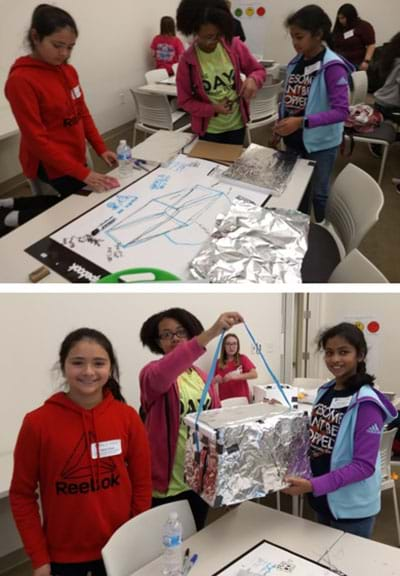Quick Look
Grade Level: Middle school
Time Required: 1 hours 30 minutes (wild guess!)
Subject Areas: Measurement, Problem Solving

Maker Challenge Recap
Students design a cooler and monitor the effectiveness of its ability to keep a bottle of ice water cold in comparison to a bottle of ice water left at room temperature. They work through the engineering design process. Students have the opportunity to brainstorm a design of their cooler and its attributes. They then choose from the materials provided to create a prototype. They have the opportunity to test their prototype by measuring the room temperature, the starting temperature of the water and graphing and monitoring the change in temperature over increments time in comparison to the room temperature water.
Maker Materials & Supplies
- Styrofoam
- aluminum foil
- newspaper
- rags
- plastic wrap
- bubble wrap
- trash bags
- cardboard squares
- flannel squares
- duct tape
- scissors
- acrylic paint
- bottles of water
- thermometer
- scale (to measure coolers)
- butcher paper or a paper roll (to display graphing to rest of the class)
- markers
Worksheets and Attachments
Visit [www.teachengineering.org/makerchallenges/view/rice-2405-cooler-design-engineering-challenge] to print or download.Subscribe
Get the inside scoop on all things TeachEngineering such as new site features, curriculum updates, video releases, and more by signing up for our newsletter!Kickoff
It is important to be able to keep food and drinks at a temperature that makes them safe for consumption, but we do not always have access to refrigeration. This is especially the case in outdoor settings such as camping, or in parts of the world where there is not access to adequate refrigeration.
Engineers, like you, can take materials that they have access to and create solutions to a given problem, such as keeping cool things cool (or hot things hot). In addition to making sure that their product functions for its purpose, engineers also consider other design elements that would affect the usability of the product from consumers, such as appearance, weight, ease of transport, and so on.
The best designs are able to keep objects cool the longest, are lightweight, easily to clean, and easily portable. An aesthetic design, something that is stylish or pleasing to the eye, is also important in a product design. As you design your cooler, keep all of these factors in mind. Also, as a point of reference, safe refrigeration temperatures are anything at or below 4.5°C (or about 40°F). Ultimately, you will be testing the functionality of your cooler by noting the change in temperature over time in comparison to leaving the ice water out at room temperature. How will your team work to keep your cool today? Let us get started!
Show students the Keep Your Cool! PowerPoint Presentation.
Resources
Refer to the Engineering Design Process hub on TeachEngineering to guide your students through the challenge.
Maker Time
Have the class organize into engineering teams of three or four students each. Encourage students to form groups that bring together people with different strengths.
Pass out the Keep Your Cool! Worksheet for students to complete throughout the challenge.
Allow the students to brainstorm and sketch a blueprint of their design. The designs should include labels for the materials they use in construction. Students need to construct a blueprint that shows both what the inside and outside will look like and what materials they plan to use. Once completed, students should share the results of their design with the rest of their group. As a group, they should then work on agreeing on what aspects of the design they will use—weighing input from each group member.
Once the group agrees on a design, the teacher can then provide the requested materials to the groups.
Questions/thoughts to guide students thinking include:
- What function will the materials that you are adding provide?
- What changes could you possibly make to improve ___________ aspect of your design (style, ease of cleaning, weight, portability, etc.)?
- Explain how your design works.
- If you were buying a cooler from the store, what would you think would be important for it to have?
Wrap Up
Have students share their design and the results of their design (including the graphing) with the rest of the class. Afterwards, ask students the following questions:
- What worked well and what didn’t?
- How would you rate your design on the design elements of functionality, ease of cleaning style, weight, and portability? (Scale of 1-5, 5 is best).
- How would you change your cooler design for the future?

Copyright
© 2019 by Regents of the University of Colorado; original © 2018 Rice UniversityContributors
Chinyere EnemchukwuSupporting Program
Nanotechnology RET, Department of Earth Science, School Science and Technology, Rice UniversityAcknowledgements
This material was developed based upon work supported by the National Science Foundation under grant no. EEC 1406885—the Nanotechnology Research Experience for Teachers at the Rice University School Science and Technology in Houston, TX. Any opinions, findings and conclusions or recommendations expressed in this material are those of the authors and do not necessarily reflect the views of the National Science Foundation.
Special thanks to Isaias Cerda, Christina Crawford, Dr. Carolyn Nichol, Dr. Han Xiao and Yuda Chen.
Last modified: September 4, 2020





User Comments & Tips